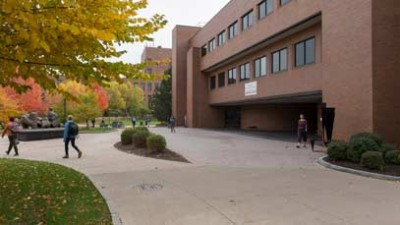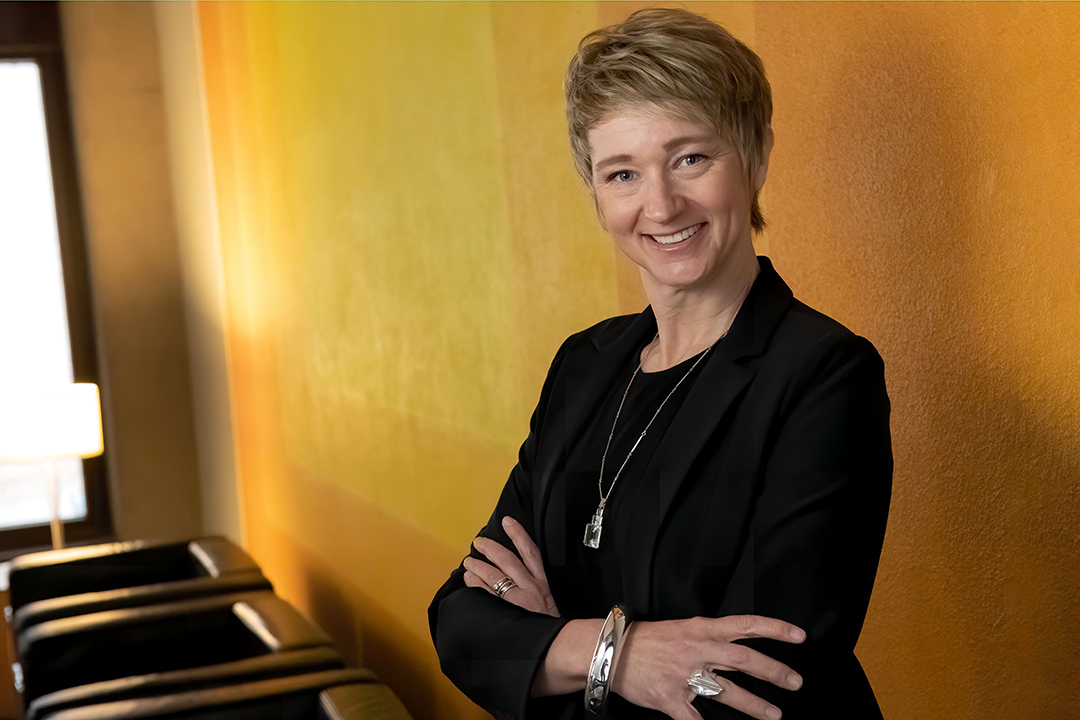Meet College of Liberal Arts Dean Anna Stenport
Elizabeth Lamark
Dean Anna Stenport is excited about the future of RIT’s College of Liberal Arts.
RIT’s College of Liberal Arts (CLA) began the academic year under new leadership.
Dean Anna Stenport joined RIT from Georgia Institute of Technology’s Ivan Allen College of Liberal Arts in September following a nationwide search. Stenport is a professor of communication and an expert in transnational cinema and media, modern literature and drama, and visual and cultural studies, with a focus on the Arctic and Nordic regions.
Now at RIT, Stenport looks forward to leading and growing the College of Liberal Arts. She answered some questions about herself and her vision for the future of the college.
What excites you about being here at RIT?
The amazing community of students, faculty, staff, and dedicated alumni who are invested in the future of the College of Liberal Arts at the heart of great student-centered research university.
Already I’ve had the opportunity to connect with people doing truly great things and using their time, connections, and resources to move CLA forward on its trajectory of achieving greatness. I’m so excited to join this energized community and look forward to the years of collaboration with everyone who is invested in seeing our college grow stronger.
I love the collaborative, open, and can-do attitude at RIT and the emphasis on creativity, innovation, and multidimensional, multidisciplinary approaches. These are things I think we do very well in CLA already and we can do even more to emphasize them.
What would you like the RIT community to know about you?
I’ll answer this question in three parts: where I come from, why I am here at RIT, and what I am passionate about.
I grew up in Sweden and I’ve lived in the United States for nearly 25 years in California, Illinois, Georgia, and now in New York state. I’ve also lived in Canada and grew up with extended family in England and France, so an internationally oriented career was on the horizon growing up. Pursuing a Ph.D. at UC Berkeley was formative–that’s where I experienced first-hand how great research universities transform lives in service of the public good.
A good portion of my career has been about building international partnerships, connecting with campuses abroad, fostering knowledge exchange, student transfer, and the integration of global perspectives into curricula. These aspects are also reflected in my research. That’s another reason I’m excited to be here at RIT and to explore further collaboration with international education and campuses abroad.
Higher education at American universities such as RIT are among the strongest vehicles and agents for positive societal change. What we do really matters because it makes the world a better place. This mission is what drew me to higher education, why I wanted to become a university professor, and continues to be a motivating element of my research. That’s also why I wanted to serve as dean of liberal arts.
We often talk about RIT’s CLA as a liberal arts school that sits within an institute of technology. Coming from Georgia Tech, you’re familiar with this setup. Why is this so important?
The liberal arts at STEM-driven institutions have distinctive and important roles to play. We live in a technologically oriented world. The liberal arts are human-centered. Ethics, politics, culture, policy, behavioral analysis, inclusive communication, and the integration of diverse perspectives are critical components to understanding our present and past and effecting positive future change. The liberal arts and STEM, together, can lead us to a more inclusive and equitable society.
Liberal arts at RIT don’t look like traditional liberal arts. For one thing, we have distinctive professional programs like criminal justice, advertising and public relations, and museum studies. In addition, our humanities, social sciences, and performing arts programs have applied, technical, and professional components embedded in the plan of study. Our faculty have played a key role in recognizing these opportunities for specialized education within the liberal arts and in developing unique, exciting options that make our graduates distinctive.
You’ll also find that RIT’s liberal arts integrates STEM perspectives in other ways, too. For example, when we talk about performing arts at RIT, we’re not only talking about ensembles and concerts and acting and theater, but we’re also talking about immersive performance with augmented reality and virtual reality, and about music technology and production. Also, we’re talking about CLA’s collaborations with the National Technical Institute for the Deaf in which we produce accessible performances with and for deaf and hard-of-hearing individuals.
These are all things that make us a unique liberal arts school. This is what liberal arts in the 21st century ought to be.
You often talk about the role liberal arts plays in creating strong leaders. Can you expand on that a bit?
Yes! The liberal arts provide a strong foundation for positive, ethical, and inclusive leadership for the future, through seeing issues from multiple perspectives, working in diverse teams, communicating clearly, being able to integrate both quantitative and qualitative analysis into decision-making, and so forth.
These are the kinds of competencies that are fostered through the liberal arts, and certainly things that we equip our students with in everything we do: from general education to graduate programs, majors, double majors, and minors.
What are you looking forward to?
Building on the many existing distinctive strengths, there’s lots to look forward to. I’ll talk about a few.
One of the first is working with faculty, student representatives, and staff to continue advancing CLA’s commitment to student success, both undergraduate and graduate. I’d like for us to pay even more attention—and we’re doing a great job of this already—to how our courses and degrees serve diverse students of today in embarking on lives of purpose and meaningful, fulfilling careers.
I hope to do this, for example, through expanding career education opportunities within the college, as well as creating strategic partnerships with industry leaders and nonprofits, and with prestigious graduate and professional programs within RIT and across the region. I am learning a lot from the college’s Student Advisory Board about these student priorities and the importance of strong career internships, co-ops, study abroad, and undergraduate research opportunities.
I’m committed to advancing the diversity, equity, inclusion, and access (DEIA) principles of RIT and to make CLA a leader in the area. Building upon the work of our new standing committee in the college, which serves to advance conversations and policy around diversity, equity, and inclusivity, I look forward to taking stock of what concrete steps we need to implement and enhance our DEIA goals.
With an extraordinary faculty committed to innovative and multidisciplinary research and education, and highly accomplished alumni and friends, the future is bright for the College of Liberal Arts at RIT. I look forward to supporting and advancing the entire community on the journey ahead.





